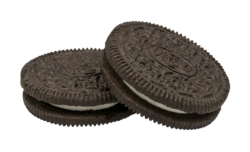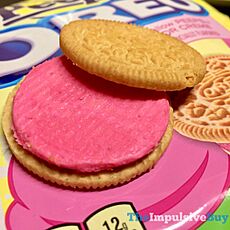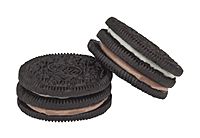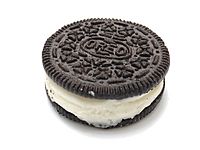Oreo facts for kids
 |
|

Two Oreo cookies
|
|
| Type | Sandwich cookie |
|---|---|
| Owner | Mondelez International |
| Country | United States |
| Introduced | March 6, 1912 |
| Markets | Worldwide |
| Tagline | "Wonderfilled" "Milk's favorite cookie" "Only Oreo" "Stay Playful" |
Oreo is a very popular American sandwich cookie. It has two dark cocoa biscuits with a sweet, creamy filling in the middle. Nabisco first introduced Oreos in 1912. Since 2012, the brand has been owned by Mondelez International.
Oreo cookies are sold in over 100 countries around the world. Many different kinds of Oreo cookies have been made over the years. Special limited-edition flavors have become very popular in recent times.
Oreos were inspired by the Hydrox cookie, which came out in 1908. However, Oreos became much more popular than Hydrox. Since 2014, Oreo has been the best-selling cookie brand in the world.
Contents
What Does the Name "Oreo" Mean?
The exact meaning of the name "Oreo" is a bit of a mystery. There are several ideas about where the name came from.
- Some think it comes from the French word or, which means "gold." The first Oreo tins were gold-colored.
- Others believe it comes from the Greek word oros, meaning "mountain." The cookie was first designed to be dome-shaped.
- Another idea is that it comes from the Greek word oraio, meaning "nice" or "attractive."
- Some people simply think the name was chosen because it was short and easy to say.
- Food writer Stella Parks suggested it might come from the Greek word Oreodaphne. This is a type of laurel plant. She noted that the original Oreo design included a laurel wreath. Also, many Nabisco cookies at that time had plant-related names.
The Story of Oreo Cookies
How Oreo Started
The "Oreo Biscuit" was first made by the National Biscuit Company, now known as Nabisco. This happened in 1912 at their factory in New York City. Today, this area is called "Oreo Way." The name Oreo was officially registered as a trademark on March 14, 1912.
The first Oreo cookie had a wreath design around its edge. The word "OREO" was in the middle. In the United States, these cookies were sold for 25 cents a pound. The very first Oreo was sold on March 6, 1912, to a store in Hoboken, New Jersey.
Changes Over the Years
The Oreo Biscuit changed its name several times. In 1921, it became "Oreo Sandwich." In 1948, it was "Oreo Crème Sandwich." Finally, in 1974, it became the "Oreo Chocolate Sandwich Cookie," which is its name today.
A new design for the cookie's face came out in 1924. The modern Oreo design, which includes the Nabisco logo, was created in 1952 by William A. Turnier. In 1920, a lemon-flavored Oreo was briefly available. However, it was stopped in 1924, leaving only the original flavor for many years.
The creamy filling we know today was developed by Sam Porcello. He was a main food scientist at Nabisco. He even had five patents related to his work on the Oreo. He also created Oreos covered in dark and white chocolate.
In the early 1990s, Nabisco changed the filling. They replaced animal fat with vegetable oil. This change also allowed the cookies to become Kosher-certified. This means they follow special food rules for Jewish people. Oreo cookies are also popular with vegans because the cream filling does not use animal products. However, there is a small chance of cross-contamination from other products made in the same factory.
Oreo in the 21st Century
In 2006, Nabisco and Kraft Foods removed trans fat from Oreo cookies. They replaced it with non-hydrogenated vegetable oil.
In June 2012, Oreo shared an advertisement with a rainbow-colored cream cookie. This was to celebrate LGBT Pride month. The cookie was just for the ad and not actually sold. Kraft Foods supported the ad, saying they celebrate diversity. This ad was followed by others for different holidays and events. For example, there was a blue, white, and red Oreo for Bastille Day.
During the Super Bowl XLVII in 2013, the power went out. Oreo's marketing team quickly tweeted, "You can still dunk in the dark." This tweet was shared almost 15,000 times! It showed how important quick, real-time marketing had become.
A research report in 2022 found something interesting. It's almost impossible to split an Oreo cookie's cream filling perfectly down the middle. The cream nearly always sticks to one side of the wafer, no matter how you twist it.
Where Are Oreos Sold?
Oreo cookies are sold all over the world. Their popularity keeps growing. According to Kraft Foods, the Oreo is the "World's Best Selling Cookie." In 2012, Time magazine reported that Oreos were available in over 100 countries.
It was estimated that over 450 billion Oreos had been sold worldwide by 2012. Just five years later, Mondelez reported that 40 billion Oreos were being made globally each year.
Oreos first came to Britain through the Sainsbury's supermarket. For several years, it was the only place to buy them in the UK. Then, in May 2008, Kraft launched Oreos across the whole UK. The packaging was changed to a tube design. A big TV advertising campaign used the famous "twist, lick, dunk" slogan. In 2020, Oreo was ranked the 16th most popular biscuit in the UK.
In the UK, Kraft also teamed up with McDonald's to offer the Oreo McFlurry. This dessert was already popular in other countries, like the US. In October 2015, the Oreo McFlurry became a permanent item on McDonald's UK menu. You can also find an Oreo-flavored "Krushem" drink at KFC stores in Britain.
The ingredients in British Oreos are a bit different from US Oreos. The British version used to contain whey powder, which meant it wasn't suitable for vegetarians. However, in December 2011, Kraft announced that Oreo production would start in the UK. Production began in May 2013 at the Cadbury factory in Sheffield.
Oreo cookies were introduced in India by Cadbury India in 2011. In Pakistan, Oreo is made and sold by Continental Biscuits Limited. In Japan, Oreo used to be made by Yamazaki Baking. But now, Mondelez makes them in China. Yamazaki then started making their own similar cookie called "Noir."
How Oreos Are Made
By 2017, over 40 billion Oreo cookies were being made each year in 18 different countries.
- For Asian markets, Oreos are made in India, Indonesia, Bahrain, and China.
- For European markets, they are made in Spain and the UK.
- For some CIS countries, they are made in Russia.
- Oreos sold in Australia come from Indonesia, China, or Bahrain.
- The Canadian version (sold under the Christie's brand) now uses vegetable oil and modified palm oil, similar to American cookies.
- Oreo production started in Pakistan in early 2014.
Oreo Boycott
In 2015, Mondelez announced it would close some American factories and move production to Mexico. This led to some people calling for an Oreo boycott. In 2016, the AFL–CIO labor group supported the boycott. They helped consumers find out which Mondelez products were made in Mexico.
What's in an Oreo?
The main ingredients of Oreo cookies have stayed mostly the same since they were first made. However, many new flavors and types have appeared.
Oreo cookies used to be made with animal fat until the mid-1990s. Then, Nabisco changed it to partially hydrogenated vegetable oil. In the mid-2000s, Nabisco removed the partially hydrogenated oil because of health concerns.
The classic Oreo cookie has 11 main ingredients:
- Sugar
- Unbleached enriched flour (which includes wheat flour, niacin, iron, thiamine, riboflavin, and folic acid)
- High oleic canola oil or palm oil
- Cocoa (treated with alkali)
- High-fructose corn syrup
- Leavening agent (like baking soda)
- Corn starch
- Salt
- Soy lecithin
- Vanillin
- Chocolate
Different Kinds of Oreos
Besides the classic Oreo, many different kinds have been made. Not all of them are available everywhere. Here are some of the popular types in the United States:
- Double Stuf Oreo: Introduced in 1974, these have about twice the amount of cream filling. They come in original, chocolate, peanut butter, mint, and birthday cake flavors. In the UK, they are called Double Creme Oreos.
- Football Oreo: These are Gridiron football-shaped Oreos, first made in 1976.
- Big Stuf Oreo: These were much larger than regular Oreos. They were sold from 1987 to 1991.
- Golden Oreo: Introduced in 2004, these have vanilla-flavored "golden" wafers instead of chocolate. They come with original, chocolate, lemon, and birthday cake cream.
- Oreo Mini: These are tiny, bite-sized Oreos, first released in 1991. They come in original, chocolate, strawberry, and mint flavors.
- Oreo Cakesters: These are soft chocolate snack cakes with cream in the middle, like a whoopie pie. They were first made in 2007, stopped in 2012, and then brought back in 2022.
- Mega Stuf Oreo: Released in 2013, these have even more cream filling than Double Stuf. They come with chocolate or golden wafers.
- Oreo Thins: Introduced in 2015, these are thinner versions of the original Oreo. They come in chocolate and golden wafers with flavors like chocolate, mint, lemon, and tiramisu.
- Chocolate Oreo: An Oreo with chocolate cream filling.
- Mint Oreo: An Oreo with mint-flavored cream filling.
- The Most Stuf: First released in 2019, these have about four times the amount of cream filling as a standard Oreo. They are now a permanent product.
- Gluten Free: Introduced in 2021, these are available in traditional and Double Stuf varieties for people who cannot eat gluten.
Special edition Double Stuf Oreo cookies are made for holidays like springtime, Halloween, and Christmas. These have colored frosting to match the holiday. For example, orange for Halloween or red and green for Christmas. Some also have special designs on the cookie wafer.
In some countries, Oreos come in flavors not found in the U.S. For example, Green Tea Oreos are only in China and Japan. Blueberry Ice Cream Oreos are available in China and Southeast Asia. There are also alfajor Oreo cookies in Argentina, which are three Oreos with vanilla filling, covered in chocolate.
Limited Edition Flavors

Since the early 2010s, Nabisco has released many limited edition flavors. These are usually in stores for a short time. Some popular ones, like Birthday Cake Oreos, have become permanent. Some limited editions are only sold at certain stores.
Limited editions often have cream flavored like a fruit or dessert. These can be familiar flavors like lemon or mint, or more unusual ones like blueberry pie or red velvet cake. Some even have different cookie wafers, like Cinnamon-Bun Oreos with cinnamon-flavored wafers. Recently, some limited editions have teamed up with other candy brands, like Reese's or Peeps.
The team at Oreo that creates these special flavors is very secret. The limited-edition flavors often help advertise Oreo's regular cookies.
Here are some notable limited edition Oreo flavors:
- Birthday Cake (2012): Celebrated Oreo's 100th birthday. Now a permanent flavor.
- Watermelon (2013): A golden Oreo with watermelon-flavored cream.
- Cookie Dough (2014): A chocolate Oreo with cookie dough-flavored cream.
- Red Velvet (2015): Red Oreo wafers with cream cheese-flavored cream.
- Key Lime Pie (2015): Graham-flavored wafers with key lime-flavored cream.
- Cinnamon Bun (2016): Cinnamon-flavored wafers with frosting-flavored cream.
- S'mores (2016): Graham-flavored wafers with chocolate and marshmallow cream.
- Swedish Fish (2016): Chocolate Oreo with red cream flavored like Swedish Fish candy.
- Peeps (2017, 2018): Golden or chocolate Oreos with marshmallow Peeps-flavored cream.
- Chocolate Hazelnut (2018): Golden Oreo with a Nutella-like cream.
- Firework (2018): Classic Oreo with Pop Rocks candy in the cream.
- Easter Egg (2019): Oval-shaped chocolate Oreo with purple cream and Easter designs.
- Lady Gaga (2020): Salmon-colored wafers with green filling, same flavor as Golden Oreo. Promoted her album Chromatica.
- Strawberry Frosted Donut (2021): Golden Oreo with strawberry and donut-flavored cream.
- Hot Chicken Wing and Wasabi: Exclusive to China.
- Oreo Pokémon (2021 US, 2024 Asia): Wafers with Pokémon characters, including a rare Mew.
- Oreo Batman (2022): Has a Batman face on the wafer.
- Oreo Blackpink (2022–2023): Pink wafers with dark chocolate cream. Promoted the K-pop group Blackpink.
- The Most Oreo Oreo (2023): Cream filling contains small bits of Oreo cookie wafer.
- Oreo Coca-Cola (2024): Part of a campaign with Coca-Cola.
Oreo Advertising
You Can Still Dunk in the Dark
During the Super Bowl XLVII in 2013, the stadium lights went out. Oreo's marketing team quickly posted on social media, "You Can Still Dunk in the Dark." This post was shared thousands of times and became a famous example of quick, clever advertising.
Oreo Daily Twist
The "Oreo Daily Twist" was a social media campaign for Oreo's 100th birthday. Every day for over three months, Oreo posted ads showing their cookies changed into something new. These ads celebrated national holidays, pop culture moments, and important events. For example, they honored the Mars rover landing, Elvis week, and the invention of Pac-Man.
Dunk Challenge
In 2017, NBA player Shaquille O'Neal was in an Oreo commercial. He promoted the #OreoDunkSweepstakes. In the ad, O'Neal did an amazing dunk with an Oreo into a glass of milk. Fans could then share their own dunking videos to win prizes.
Global Oreo Vault
In October 2020, Nabisco announced they had built a small concrete bunker in Svalbard, Norway. This "Global Oreo Vault" was made to protect the Oreo recipe. It was a fun way to talk about a small asteroid that was expected to pass by Earth.
The Word "Oreo" in Culture
Because of their dark cookies and white filling, Oreo cookies have sometimes been used as a way to describe relationships between different groups of people.
For example, the term "Oreo" has sometimes been used to describe a person of mixed heritage or an African-American person who is seen as trying to "act white." This comparison comes from the cookie's appearance: "black on the outside and white on the inside." In the 1976 movie A Star Is Born, Barbra Streisand's character was the white singer in a group called The Oreos, with two black singers.
In 2021, a political leader named Gary O'Connor used the term when talking about Senator Tim Scott, who is an African-American Republican. O'Connor later apologized for his comments.
See also
 In Spanish: Oreo para niños
In Spanish: Oreo para niños





